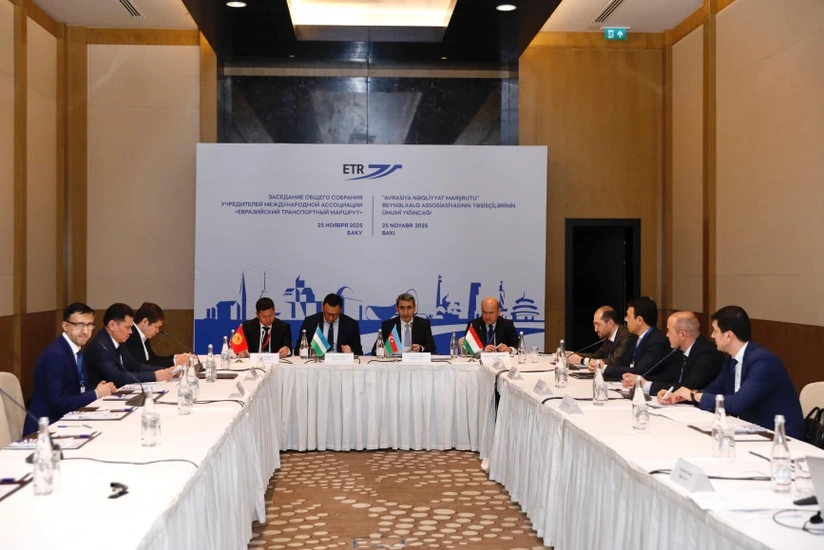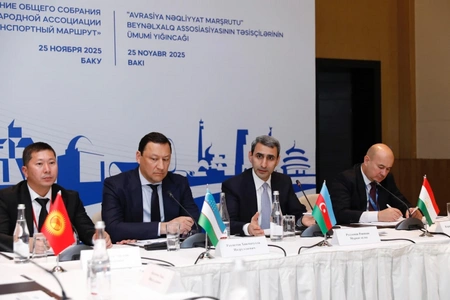Azerbaijan becomes significant player within Middle Corridor
- 25 November, 2025
- 19:28

The southern branch of the Middle Corridor will allow Azerbaijan to become the main bridge between Central Asia and Europe and increase transit volumes through the country's territory.
As Report informs, this was stated by the chairman of Azerbaijan Railways CJSC (ADY) Rovshan Rustamov at the general meeting of the founding countries of the International Association Eurasian Transport Route.
He noted that the association with headquarters in Baku has successfully completed registration in accordance with the legislation of Azerbaijan.
According to the chairman of ADY, against the background of growing freight transportation from China to Europe and in the opposite direction, there was a need to diversify routes, and for these purposes, it is important to fully ensure the functioning of the Eurasian Transport Route.
This route, considered the southern branch of the Middle Corridor, passes through China, Kyrgyzstan, Tajikistan, Uzbekistan, Turkmenistan, Azerbaijan, Georgia, and Türkiye. Multimodal transportation from Kashgar city (PRC) to Azerbaijan via Kyrgyzstan, Uzbekistan, and Turkmenistan has already started this month.
It was stated that the construction of the Uzbekistan-Kyrgyzstan-China railway will also enhance the role of the Eurasian Transport Route, as well as connect the Middle and Trans-Afghan corridors, opening new opportunities for Afghanistan and Pakistan.
According to the chairman of ADY, the development of the southern branch of the Middle Corridor will allow Azerbaijan to become the main bridge between Central Asia and Europe and increase transit volumes through the country's territory, maximizing the use of important infrastructure such as the Baku port and the Baku-Tbilisi-Kars railway. He also added that the Zangazur corridor will further expand this potential.
At the event, the parties also discussed preparations for launching the association's activities. After discussions, agenda items were approved – the corporate structure of the association, the structure of the secretariat and working bodies, planned activities for organizing its operations, and other issues.
It was also decided to prepare regulations for the Eurasian Transport Route development committee and special working groups on dispatching, infrastructure development, commerce, digitalization, marketing, communications, and legal issues, as well as a draft detailed marketing plan for 2026, and to present the agreed projects for discussion at the next General Assembly meeting.
The need to implement a series of measures to organize the activities of the international association was identified, including analyzing the current situation in intermodal transportation along the Eurasian Transport Route, identifying and eliminating "bottlenecks", implementing IT solutions and digital platforms for transportation management, determining a schedule, resources, and priorities for eliminating constraints, as well as ensuring its development.
In addition, the importance of establishing partnerships between the association and stakeholders in the Eurasian region (including Central European countries, China, Pakistan) and international organizations was emphasized, as well as taking measures to promote the route in order to popularize it in the Eurasian intermodal transport services market and strengthen its position.
On September 20, 2024, the International Association Eurasian Transport Route was established in Baku with the participation of ADY, Uzbekistan Railways, National Company Kyrgyz Temir Zholu, and Tajik Railways. The purpose of creating the association is to attract transit cargo, develop integrated logistics products, create a unified technology for transportation processes, implement an effective tariff policy, and optimize costs.
Azerbaijan's chairmanship in the association strengthens ADY's position as one of the main regional operators, transforming Azerbaijan into a strategic dispatch center where key decisions are made on organizing transit throughout the southern branch of the Middle Corridor. This allows the company to influence the formation of tariff policy, standardization of logistics procedures, and development of digital platforms for coordinating transportation, and also creates conditions for attracting international investments in railway projects.


